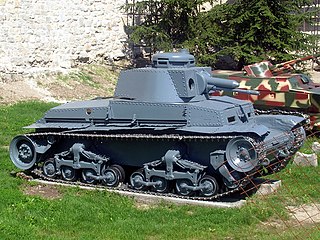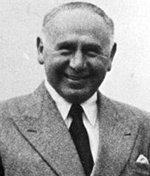
The Panzer I was a light tank produced by Nazi Germany in the 1930s. Its name is short for Panzerkampfwagen I, abbreviated as PzKpfw I. The tank's official German ordnance inventory designation was Sd.Kfz. 101.

Panzerkampfwagen VIII Maus was a German World War II super-heavy tank completed in late 1944. It is the heaviest fully enclosed armored fighting vehicle ever built. Five were ordered, but only two hulls and one turret were completed, the turret being attached before the testing grounds were captured by advancing Soviet military forces.

The Panzerkampfwagen 35(t), commonly shortened to Panzer 35(t) or abbreviated as Pz.Kpfw. 35(t), was a Czechoslovak-designed light tank used mainly by Nazi Germany during World War II. The letter (t) stood for tschechisch (German for "Czech"). In Czechoslovak service, it had the formal designation Lehký tank vzor 35 (Light Tank Model 35), but was commonly referred to as the LT vz. 35 or LT-35.

The Toldi was a Hungarian light tank of World War II, developed on the basis of the Swedish Landsverk L-60. It was named after the 14th century Hungarian knight Miklós Toldi. The Toldi was made in several different variants including some armed with a 20 mm gun, some armed with a 40 mm gun, some fitted with schürzen plates, and even a prototype tank destroyer variant armed with a 75 mm gun. At least one was even fitted with heavy anti-tank rocket launchers.

Nazi Germany developed numerous tank designs used in World War II. In addition to domestic designs, Germany also used various captured and foreign-built tanks.

Tanks were initially deployed in World War I, engineered to overcome the deadlock of trench warfare. Between the two world wars, tanks were further developed. Although they had demonstrated their battlefield effectiveness, only a few nations had the industrial resources to design and build them. During and after World War I, Britain and France pioneered tank technology, with their models generally serving as a blueprint for other countries. However, this initial advantage would slowly diminish during the 1930s, shifting in favor of the Soviet Union and, to a lesser degree, Nazi Germany.

The Hotchkiss H35 or Char léger modèle 1935 H was a French cavalry tank developed prior to World War II. Despite having been designed from 1933 as a rather slow but well-armoured light infantry support tank, the type was initially rejected by the French Infantry because it proved difficult to steer while driving cross-country, and was instead adopted in 1936 by the French Cavalry arm.

The 39M Csaba (t͡ʃɒbɒ) was a Hungarian armoured car designed by Nicholas Straussler. It was produced for the Royal Hungarian Army during World War II and used extensively on the Eastern Front fighting against the Soviet Union.

Nicholas Peter Sorrel Straussler was an engineer mainly remembered for devising the flotation system used by Allied amphibious DD tanks during World War II. He also designed several armoured cars and tanks, including the 39M Csaba armoured car and the Straussler V-4 amphibious light tank. Born in Hungary, he developed a reputation as an innovative automotive engineer before becoming a British citizen during the interwar period. His work was mainly to do with amphibious, off-road and military vehicles.

Verdeja was the name of a series of light tanks developed in Spain between 1938 and 1954 in an attempt to replace German Panzer I and Soviet T-26 tanks in Spanish service.

This article deals with the tanks serving in the German Army throughout history, such as the World War I tanks of the Imperial German Army, the interwar and World War II tanks of the Nazi German Wehrmacht, the Cold War tanks of the West German and East German Armies, all the way to the present day tanks of the Bundeswehr.

The Principality of Upper Hungary was a short-lived Ottoman vassal state ruled by Imre Thököly.
The 44M Tas was a Hungarian heavy tank/medium tank design of World War II. It was developed to combat heavily armored Soviet tanks encountered on the Eastern Front and to replace the older Turán I and Turán II tanks which Hungary operated, modernising Hungary's armoured forces. The Tas somewhat resembled the German Panther tank in terms of both looks and capabilities. It was to be well armored – up to 120 mm thick and with sloped armor. The main armament would likely have been a Hungarian built heavily modified anti-tank version of the 80 mm Bofors AA gun. The only prototypes built were destroyed when the Americans bombed the Weiss Manfréd factory in July 1944.

This article deals with the history of tanks employed by military forces in Czechoslovakia from the interwar period, and the more conventional tanks designed for the Czechoslovak Army before World War II, and the tanks that ended up as Panzers of the German Wehrmacht during World War II, or in the use of other countries who purchased them before the war began.
The Battle of Olšava was an engagement of Bohemian and Hungarian troops near the Olšava River along the frontier of the two realms in May 1116. The event started as a peaceful meeting between the young Stephen II of Hungary and Vladislaus I of Bohemia, according to Hungarian chronicles. The Czech Cosmas of Prague wrote that the Hungarians came to the border to provocate a war.
The 43M Turán III or 44M Turán III was a Hungarian medium tank of World War II. It was based on the 41M Turán II medium tank but was equipped with a significantly larger turret and a much more powerful long-barreled 75 mm gun.
Vata or Vatha was a Hungarian noble, lord of the castle of Békés and chief of a tribe in Körösvidék. He is known for being the leader of the Vata pagan uprising.

The Weiss Manfréd WM-23 Ezüst Nyíl was a Hungarian fighter aircraft of World War II developed by the Manfréd Weiss Steel and Metal Works. Designed by Samu Béla and his team, the WM-23 was an entirely Hungarian design with retractable landing gear, a three-bladed variable-pitch propeller, a closed canopy, inverted gull wings and an elliptical low-wing design. Development started in summer 1939 with one prototype produced and test flown. Demonstrating good flying characteristics and generally being considered an excellent design, the WM-23 was planned to enter mass production. However, the prototype was destroyed on 21 April 1942, and by this time the MÁVAG Héja fighter was being used which acceptably filled the intended role of the WM-23. Therefore, it was decided to not allocate further resources to completing the project, and to cancel it.
Paul Stupar was an Austro-Hungarian naval officer holding the rank of rear admiral.













